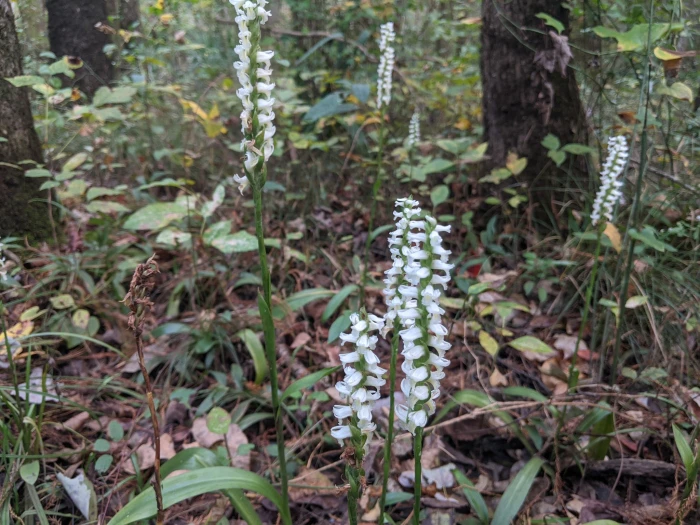Marsh Lady’s Tresses
(Spiranthes odorata)
Marsh Lady’s Tresses (Spiranthes odorata)
/
/

Austin Pursley
Public Domain
Image By:
Austin Pursley
Recorded By:
Copyright:
Public Domain
Copyright Notice:
Photo by: Austin Pursley | License Type: Public Domain | License URL: http://creativecommons.org/publicdomain/zero/1.0/ | Rights Holder: Austin Pursley | Publisher: iNaturalist | Date Created: 2020-11-06T15:40:05-08:00 |












































Estimated Native Range
Climate Requirements for Beaverton, Oregon
| This Plant | Your Site | Plant Suitability for Your Location | ||
|---|---|---|---|---|
| • Precipitation | 30" - 66" | 42" | Aquatic | Aquatic |
| • High Temp. | 71°F - 94°F | 81°F | Your summer temperatures are normal for this plant. | Excellent |
| • Low Temp. | 14°F - 63°F | 34°F | Your winter temperatures are normal for this plant | Excellent |
This plant should grow well at your location with about N inches per year (Y minutes per month) of irrigation.
Summary
Spiranthes odorata, commonly known as Marsh Lady’s Tresses, is a perennial herb native to wet meadows, marshes, and the edges of streams and ponds in the southeastern United States. It typically grows up to 50 cm (20 in) tall and broad, with a distinctive growth pattern featuring flowers borne in dense vertical rows on sturdy green spikes. The flowers are slightly twisted, which is reflected in the genus name Spiranthes, meaning "twisted flower." This unique spiraling effect is due to uneven cell growth. The white, hooded, and fragrant flowers appear in late summer and autumn, adding a delicate charm to the garden. Marsh Lady’s Tresses is pollinated by bumblebees, contributing to the local ecosystem.
This orchid is valued for its fragrant, showy flowers and its ability to thrive in moist, fertile conditions. It is often used in water gardens, bog gardens, and as a naturalizing plant in damp areas. While it is hardy down to −10 °C (14 °F), it requires protection in the form of a dry mulch during winter in frost-prone regions. The cultivar ‘Chadd’s Ford’ has received the Royal Horticultural Society’s Award of Garden Merit, indicating its exceptional performance in gardens. For successful cultivation, Marsh Lady’s Tresses prefers part shade and soils with slow or medium drainage, and it requires medium to high amounts of water to mimic its natural wetland habitat. Potential problems include root rot if drainage is insufficient and damage from slugs and snails.CC BY-SA 4.0
This orchid is valued for its fragrant, showy flowers and its ability to thrive in moist, fertile conditions. It is often used in water gardens, bog gardens, and as a naturalizing plant in damp areas. While it is hardy down to −10 °C (14 °F), it requires protection in the form of a dry mulch during winter in frost-prone regions. The cultivar ‘Chadd’s Ford’ has received the Royal Horticultural Society’s Award of Garden Merit, indicating its exceptional performance in gardens. For successful cultivation, Marsh Lady’s Tresses prefers part shade and soils with slow or medium drainage, and it requires medium to high amounts of water to mimic its natural wetland habitat. Potential problems include root rot if drainage is insufficient and damage from slugs and snails.CC BY-SA 4.0
Plant Description
- Plant Type: Herb
- Height: 0.8-2 feet
- Width: 0.8-1 feet
- Growth Rate: Moderate
- Flower Color: White
- Flowering Season: Fall
- Leaf Retention: Deciduous
Growth Requirements
- Sun: Part Shade
- Water: Medium, High
- Drainage: Slow, Medium
Common Uses
Bee Garden, Butterfly Garden, Deer Resistant, Fragrant, Showy Flowers, Street Planting, Water Garden
Natural Habitat
Wet meadows, marshes, and the edges of streams and ponds in the southeastern United States
Other Names
Common Names: Common Lady’s Tresses, Marsh Ladies’-Tresses, Fragrant Ladies’-Tresses, Marsh Ladiestresses
Scientific Names: Spiranthes odorata, Neottia odorata, Spiranthes cernua var. odorata, Gyrostachys odorata, Ibidium odoratum, Spiranthes cernua subsp. odorata, Triorchis odoratus, Triorchos odoratus, Triorchos trilobus
GBIF Accepted Name: Spiranthes odorata (Nutt.) Lindl.